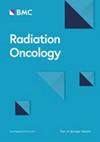Feasibility of Biology-guided Radiotherapy (BgRT) Targeting Fluorodeoxyglucose (FDG) avid liver metastases
IF 3.3
2区 医学
Q2 ONCOLOGY
引用次数: 0
Abstract
Biology-guided radiotherapy (BgRT) is a novel radiation delivery approach utilizing fluorodeoxyglucose (FDG) activity on positron emission tomography (PET) imaging performed in real-time to track and direct RT. Our institution recently acquired the RefleXion X1 BgRT system and sought to assess the feasibility of targeting metastatic sites in various organs, including the liver. However, in order for BgRT to function appropriate, adequate contrast in FDG activity between the tumor and the background tissue, referred to as the normalized SUV (NSUV), is necessary for optimal functioning of BgRT. We reviewed the charts of 50 lung adenocarcinoma patients with liver metastases. The following variables were collected: SUVmax and SUVmean for each liver metastasis, SUVmean and SUVmax at 5 and 10 mm radially from the lesion, and NSUV at 5 mm and 10 mm (SUVmax of the liver metastasis divided by SUV mean at 5 mm at 10 mm respectively). 82 measurable liver metastases were included in the final analysis. The average SUVbackground of liver was 2.26 (95% confidence interval [CI] 2.17–2.35); average SUVmean for liver metastases was 5.31 (95% CI 4.87–5.75), and average SUVmax of liver metastases was 9.19 (95% CI 7.59–10.78). The average SUVmean at 5 mm and 10 mm radially from each lesion were 3.08 (95% CI 3.00-2.16) and 2.60 (95% CI 2.52–2.68), respectively. The mean NSUV at 5 mm and 10 mm were 3.13 (95% CI 2.53–3.73) and 3.69 (95% CI 3.00-4.41) respectively. Furthermore, 90% of lesions had NSUV greater than 1.45 at 5 mm and greater than 1.77 at 10 mm. This is the first study to comprehensively characterize FDG contrast between the liver tumor and background, referred to as NSUV. Due to the high background SUV normally found in the liver, this work will be valuable for guiding optimization of BgRT for treating liver metastases in the future using the RefleXion® X1 and potentially other similar BgRT platforms.针对含氟脱氧葡萄糖(FDG)肝转移灶的生物导向放射治疗(BgRT)的可行性
生物引导放射治疗(BgRT)是一种新型放射治疗方法,它利用正电子发射断层扫描(PET)成像中的氟脱氧葡萄糖(FDG)活性实时跟踪和引导 RT。我院最近购买了 RefleXion X1 BgRT 系统,并试图评估靶向包括肝脏在内的各器官转移部位的可行性。然而,为了使 BgRT 发挥适当的作用,肿瘤与背景组织之间必须有足够的 FDG 活性对比度,即归一化 SUV(NSUV)。我们回顾了 50 名肝转移肺腺癌患者的病历。我们收集了以下变量每个肝转移灶的 SUVmax 和 SUVmean、距病灶径向 5 毫米和 10 毫米处的 SUVmean 和 SUVmax,以及 5 毫米和 10 毫米处的 NSUV(肝转移灶的 SUVmax 分别除以 5 毫米和 10 毫米处的 SUVmean)。82个可测量的肝转移灶被纳入最终分析。肝脏的平均SUVbackground为2.26(95%置信区间[CI] 2.17-2.35);肝转移灶的平均SUVmean为5.31(95% CI 4.87-5.75),肝转移灶的平均SUVmax为9.19(95% CI 7.59-10.78)。每个病灶径向5毫米和10毫米处的平均SUVmean分别为3.08(95% CI 3.00-2.16)和2.60(95% CI 2.52-2.68)。5 毫米和 10 毫米处的平均 NSUV 分别为 3.13(95% CI 2.53-3.73)和 3.69(95% CI 3.00-4.41)。此外,90%的病变在 5 毫米处的 NSUV 大于 1.45,在 10 毫米处的 NSUV 大于 1.77。这是第一项全面描述肝脏肿瘤与背景之间FDG对比度(即NSUV)的研究。由于肝脏中通常存在较高的本底 SUV,这项工作将对指导未来使用 RefleXion® X1 和其他潜在的类似 BgRT 平台治疗肝转移瘤的 BgRT 优化非常有价值。
本文章由计算机程序翻译,如有差异,请以英文原文为准。
求助全文
约1分钟内获得全文
求助全文
来源期刊

Radiation Oncology
ONCOLOGY-RADIOLOGY, NUCLEAR MEDICINE & MEDICAL IMAGING
CiteScore
6.50
自引率
2.80%
发文量
181
审稿时长
3-6 weeks
期刊介绍:
Radiation Oncology encompasses all aspects of research that impacts on the treatment of cancer using radiation. It publishes findings in molecular and cellular radiation biology, radiation physics, radiation technology, and clinical oncology.
 求助内容:
求助内容: 应助结果提醒方式:
应助结果提醒方式:


